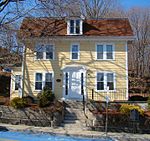Chelsea Parade Historic District
Georgian architecture in ConnecticutHistoric districts in New London County, ConnecticutHistoric districts on the National Register of Historic Places in ConnecticutNRHP infobox with nocatNational Register of Historic Places in New London County, Connecticut ... and 1 more
Norwich, Connecticut

The Chelsea Parade Historic District encompasses a predominantly residential area north of downtown Norwich. Centered around the Chelsea Parade, a triangular public park, the area has long been a preferred residential area for the city's upper classes, and includes a catalog of architecture from the 18th to 20th centuries. It includes 565 contributing buildings, two other contributing sites, and six contributing objects over an area of 205 acres (83 ha). The district was listed on the National Register of Historic Places in 1989.
Excerpt from the Wikipedia article Chelsea Parade Historic District (License: CC BY-SA 3.0, Authors, Images).Chelsea Parade Historic District
Washington Street, Norwich Norwichtown
Geographical coordinates (GPS) Address Nearby Places Show on map
Geographical coordinates (GPS)
| Latitude | Longitude |
|---|---|
| N 41.533611111111 ° | E -72.081944444444 ° |
Address
Washington Street 173
06360 Norwich, Norwichtown
Connecticut, United States
Open on Google Maps











